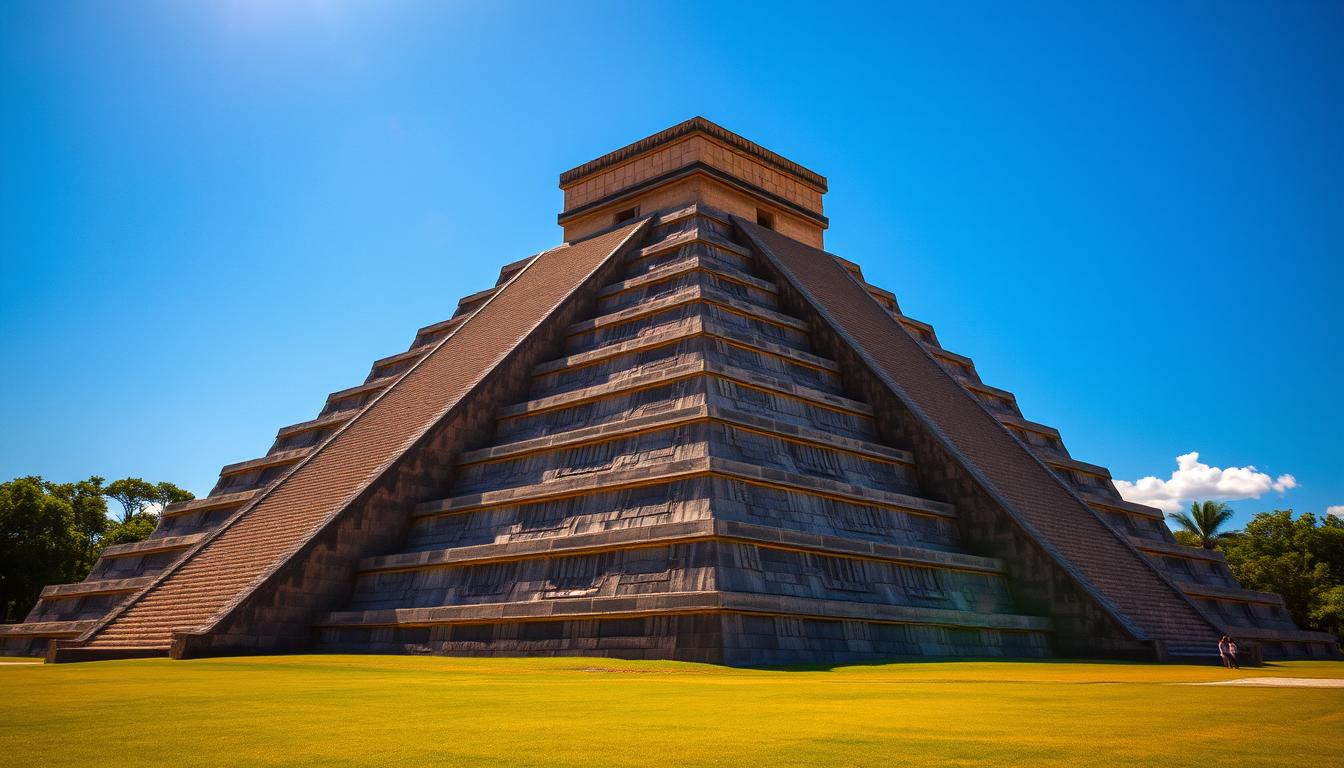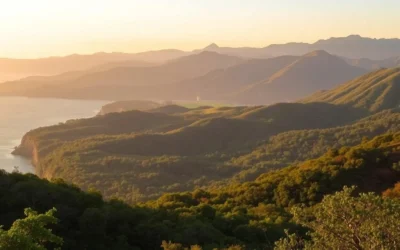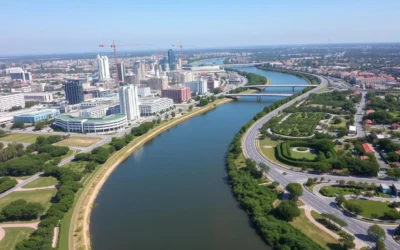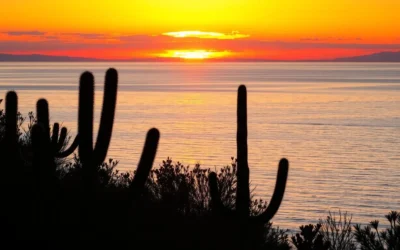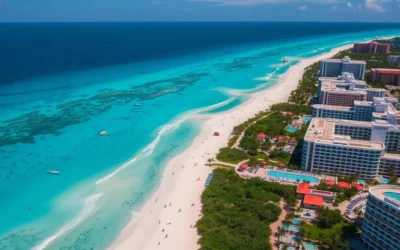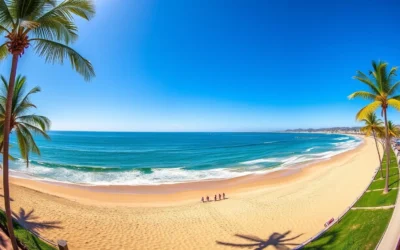✓ Accommodations✓ Flights✓ Rental Cars✓ Tours & Activities
Have you ever wondered what makes a place truly unforgettable? Imagine standing before a towering pyramid, its steps steeped in history, and feeling the weight of centuries beneath your feet. This is the magic of Chichen Itza, a site that has captivated visitors for generations.
Located in the heart of the Yucatan Peninsula, this ancient Mayan city is more than just a tourist destination. It’s a journey through time, offering a glimpse into a civilization that thrived over 1,500 years ago. From the iconic El Castillo to the mysterious cenotes, every corner tells a story.
Planning your visit? Arriving early not only helps you beat the crowds but also allows you to experience the site’s serene beauty. Whether you’re a history buff or simply seeking adventure, Chichen Itza promises an experience like no other.
Key Takeaways
- Chichen Itza is a UNESCO World Heritage Site and one of the New Seven Wonders.
- The site features iconic structures like El Castillo and sacred cenotes.
- Visiting early in the morning enhances your experience.
- The Yucatan Peninsula offers a rich cultural and historical backdrop.
- Planning ahead ensures a smooth and memorable trip.
Discover the History and Cultural Legacy of Chichen Itza
Step into a world where history and culture collide in breathtaking ways. This ancient city, built by the Mayan civilization, stands as a testament to their ingenuity and spiritual depth. From towering pyramids to sacred cenotes, every structure tells a story of a society that thrived over a thousand years ago.
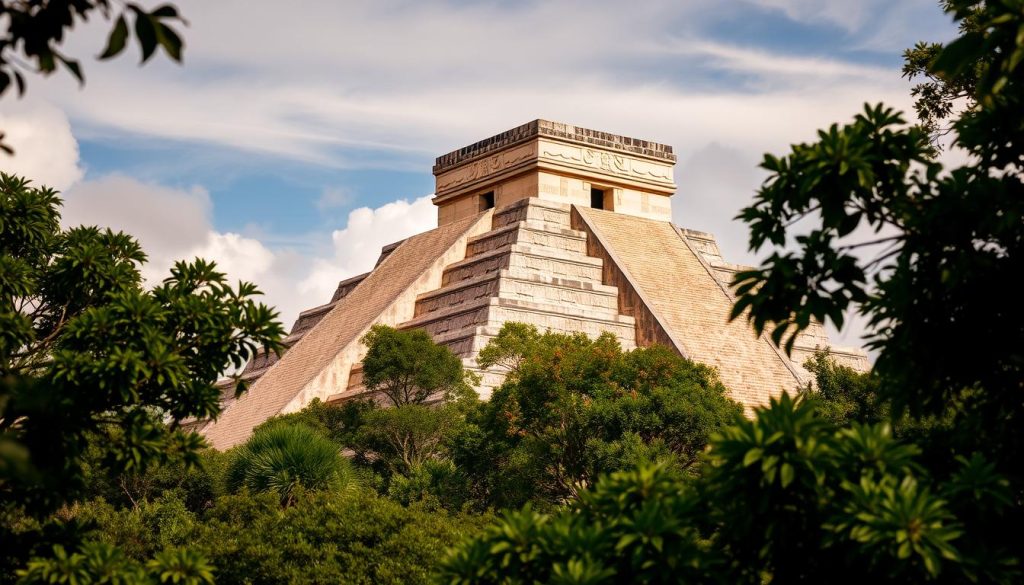
Ancient Mayan Civilization Overview
The Mayan people inhabited this site from around AD 750 to AD 1200, creating a city that became a hub of political, economic, and religious activity. El Castillo, the iconic pyramid, is a marvel of architectural precision. Its 365 steps represent the days of the year, showcasing the Mayans’ deep connection to celestial phenomena.
Other structures, like the Great Ball Court, reveal the importance of ritual and sport in their culture. This massive court, larger than a modern football field, was the stage for games that held both spiritual and political significance.
UNESCO World Heritage Insights
In 1988, this site was designated a UNESCO World Heritage Site, recognizing its cultural and historical importance. Its inclusion as one of the New Seven Wonders of the World in 2007 further cemented its global significance. The site’s preservation allows visitors to experience the grandeur of a civilization that once dominated the region.
Exploring with a knowledgeable guide can deepen your understanding of the ruins. They provide insights into the rituals, ceremonies, and daily life of the ancient Mayans, making your visit even more enriching.
Planning Your Visit: Tips and Essentials
To make the most of your adventure, knowing the essentials is key. Whether you’re traveling by bus, car, or booking a private tour, preparation ensures a smooth and memorable experience. Let’s dive into the details to help you plan your trip with confidence.
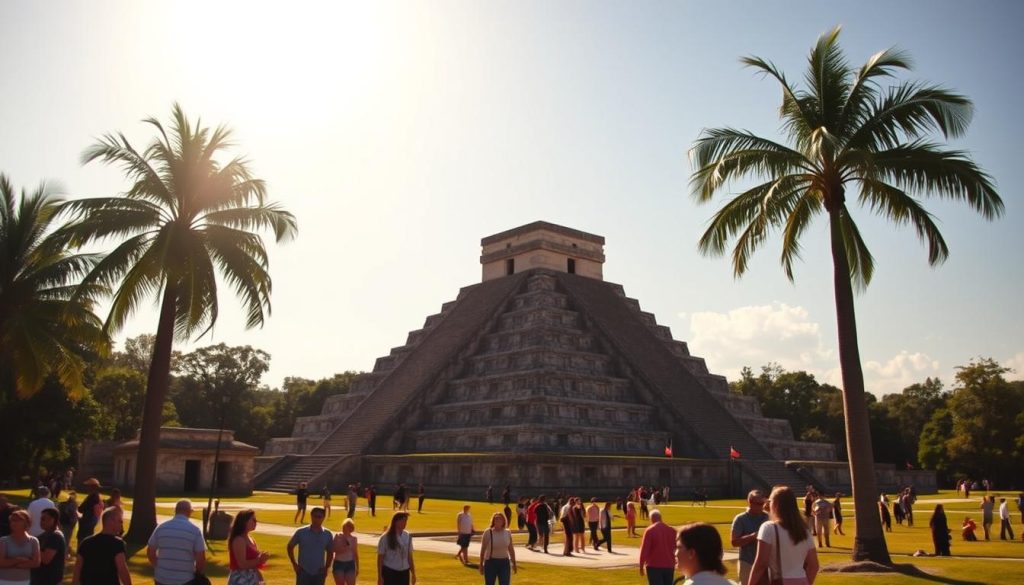
How to Get There
Reaching this iconic site is straightforward. From cities like Cancun or Tulum, buses run regularly, offering a budget-friendly option. If you prefer flexibility, renting a car allows you to explore at your own pace. For a hassle-free experience, consider booking a private tour, which often includes a knowledgeable guide and transportation.
Staying overnight in nearby Valladolid can simplify your logistics. This charming town is just a short drive away and provides easy access to the ruins. Plus, it’s a great base for exploring other attractions in the area.
Best Time to Visit and Avoid Crowds
Timing is everything when visiting popular destinations. Arriving early in the morning, ideally by 8 AM, helps you beat the crowds and the midday heat. This is especially important during peak tourist seasons, such as spring and autumn equinoxes.
If you’re visiting during the low season (May to September), you’ll encounter fewer people, but be prepared for hot and humid weather. Wear comfortable footwear, bring sun protection, and stay hydrated to make your exploration enjoyable.
By planning ahead and following these tips, you’ll ensure a stress-free and enriching visit to this historic structure.
Top Tours to Experience Chichen Itza
Exploring this iconic site can be a transformative experience when you choose the right tour. From all-inclusive packages to private excursions, there’s an option for every traveler. Let’s dive into the best ways to explore this ancient wonder.
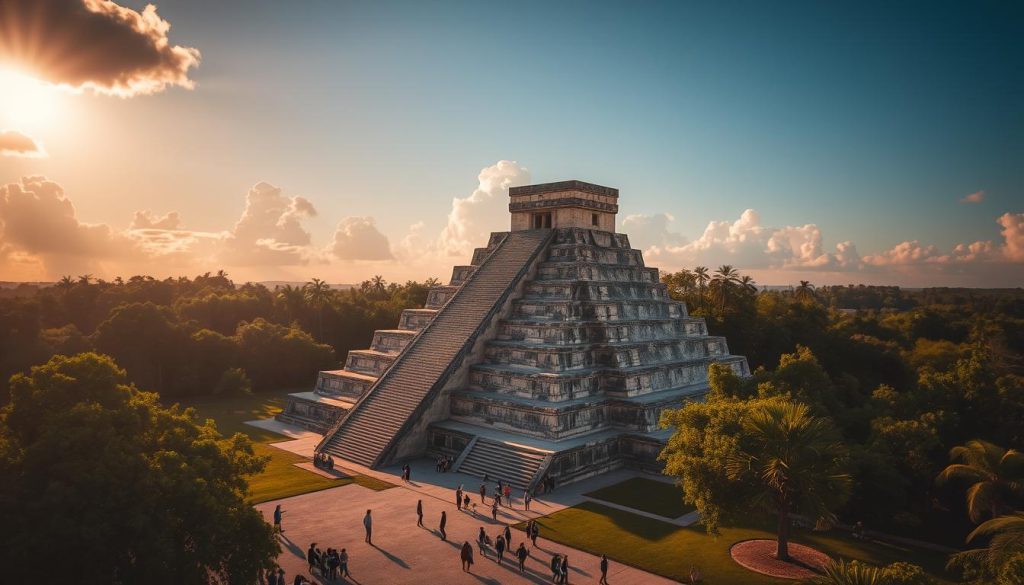
All-Inclusive, Small Group, and Private Options
For a seamless experience, consider an all-inclusive tour. These packages often include transportation, meals, and a knowledgeable guide. Small group tours, like the Excursiones Riviera Maya option, limit the group size to 20, ensuring a personalized experience.
If you prefer exclusivity, a private tour might be your best bet. My Quest Concierge’s VIP option offers a tailored itinerary, allowing you to explore at your own pace. These tours often include stops at nearby attractions, such as cenotes or colonial towns.
Local Expert and Budget-Friendly Choices
Local guides bring the site’s history to life, sharing insights into the Mayan civilization and the significance of each structure. Budget-friendly tours, like the early-access option, provide 3 hours at the ruins, plus a cenote swim and lunch.
Here’s a quick comparison of popular tours:
| Tour Type | Duration | Inclusions |
|---|---|---|
| All-Inclusive | 10-12 hours | Transport, guide, lunch, cenote stop |
| Small Group | 8-10 hours | Transport, guide, lunch |
| Private VIP | 10 hours | Custom itinerary, guide, lunch |
No matter which tour you choose, arriving early ensures you beat the crowds and enjoy the site’s serene beauty. Wear comfortable shoes, bring sunscreen, and stay hydrated to make the most of your visit.
Self-Guided Exploration at Your Own Pace
Exploring ancient ruins on your own terms offers a unique sense of freedom and discovery. A self-guided tour allows you to set your rhythm, soaking in the history and beauty of the site without the constraints of a group schedule. This approach lets you uncover hidden details and connect more intimately with the surroundings.
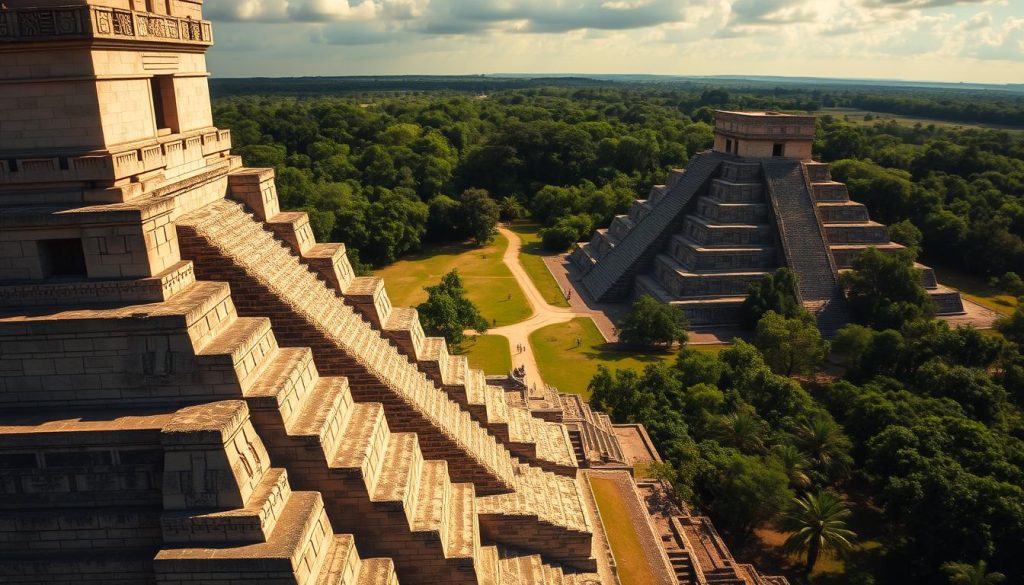
Navigating the Ruins Independently
To make the most of your visit, start by planning your route. The site spans approximately 4 square miles, so focusing on key areas like El Castillo and the Great Ball Court ensures you don’t miss the highlights. Arriving early helps you avoid crowds and enjoy cooler temperatures.
Consider renting an audio guide or downloading a self-guided app. These tools provide fascinating insights into the Mayan civilization and the significance of each structure. On-site experts are also available for hire if you prefer a more personalized experience.
Here are some practical tips for a smooth self-guided adventure:
- Wear comfortable shoes for walking on uneven terrain.
- Bring sunscreen, a hat, and plenty of water to stay hydrated.
- Take breaks in shaded areas to rest and reflect.
- Use a map or app to navigate efficiently and avoid getting lost.
Exploring independently allows you to linger at your favorite spots and create a personalized itinerary. This method fosters a deeper connection with the site’s historical ambiance.
| Self-Guided Tips | Benefits |
|---|---|
| Plan your route | Maximize time and cover key areas |
| Use audio guides | Gain insights into the site’s history |
| Arrive early | Avoid crowds and enjoy cooler weather |
| Stay hydrated | Ensure comfort during your exploration |
By following these tips, you’ll enjoy a memorable and enriching visit to this iconic site. Whether you’re a history enthusiast or simply seeking adventure, a self-guided tour offers the freedom to explore at your own pace.
Discover Stunning Cenotes and Natural Attractions
The Yucatan Peninsula is home to some of the most breathtaking natural wonders, and cenotes are at the heart of its allure. These freshwater sinkholes, formed over millennia, are not just swimming spots—they are sacred places steeped in history and culture. Whether you’re seeking adventure or a moment of tranquility, cenotes offer an unforgettable experience.
Cenote Ik Kil and the Sacred Cenote Experience
One of the most famous cenotes, Cenote Ik Kil, is just a short drive from the ruins. Its towering walls draped in vines and crystal-clear waters make it a favorite among visitors. This cenote is perfect for a refreshing swim after a day of exploring.
For a deeper connection to history, the Sacred Cenote holds immense cultural significance. Used by the Mayans for rituals and ceremonies, it’s a place where the past feels alive. While swimming isn’t allowed here, the site’s spiritual ambiance is worth the visit.
Hidden Gems and Other Must-Visit Cenotes
If you prefer a quieter experience, venture off the beaten path to discover hidden cenotes. These lesser-known spots offer the same natural beauty without the crowds. Cenote Suytun, with its dramatic light beams, and Cenote Oxman, surrounded by lush greenery, are just two examples of these hidden treasures.
Here’s a quick guide to some of the most popular cenotes:
| Cenote | Distance from Ruins | Highlights |
|---|---|---|
| Cenote Ik Kil | 3 km | Vine-covered walls, swimming allowed |
| Sacred Cenote | On-site | Historical significance, no swimming |
| Cenote Suytun | 55 km | |
| Cenote Oxman | 40 km | Lush surroundings, rope swing |
When visiting cenotes, remember to bring swimwear, a towel, and eco-friendly sunscreen. Many cenotes have strict rules to protect their delicate ecosystems. Arriving early ensures you’ll have the place to yourself and can fully enjoy its serene beauty.
“Cenotes are not just natural wonders; they are windows into the soul of the Yucatan’s landscape and history.”
By exploring these natural attractions, you’ll add a unique dimension to your trip, blending adventure with cultural discovery.
Where to Stay: Top Accommodations Near the Ruins
Finding the perfect place to stay can elevate your travel experience to new heights. Whether you’re seeking luxury, sustainability, or affordability, there’s an option to suit your needs. Staying close to the ruins not only saves time but also immerses you in the region’s rich cultural ambiance.
Luxury and Boutique Stays
For those who want to indulge, Mayaland Hotel & Bungalows offers a five-star experience just steps from the ruins. Its lush gardens and private access to the site make it a top choice. Another standout is Hacienda Chichen Resort, a boutique hotel blending colonial charm with eco-friendly practices.
These stays often include amenities like pools, guided tours, and gourmet dining. They’re perfect for travelers who want comfort and convenience while exploring the Yucatan Peninsula.
Budget-Friendly and Eco-Friendly Options
If you’re traveling on a budget, nearby Valladolid offers affordable and charming accommodations. Hotels like Casa Palagui Colonial provide clean, comfortable rooms with air conditioning, ideal for families or solo travelers.
For eco-conscious visitors, Hacienda Sacnicte combines sustainability with comfort. Its outdoor pool and lush surroundings create a relaxing retreat after a day of exploration. Staying here supports local communities and preserves the region’s natural beauty.
Here’s a quick guide to choosing the right stay:
- Luxury: Mayaland Hotel & Bungalows or Hacienda Chichen Resort.
- Budget: Casa Palagui Colonial or Xuux Peek Hotel.
- Eco-Friendly: Hacienda Sacnicte or other boutique options.
No matter where you stay, you’ll have easy access to the ruins and nearby attractions. Plan ahead to secure your ideal accommodation and make the most of your visit.
Practical Tips for a Smooth Trip
Preparing for your trip ensures a seamless and enjoyable experience. Whether you’re exploring ancient ruins or swimming in cenotes, having the right essentials and knowing how to stay safe in the tropical climate can make all the difference. Here’s how to make the most of your adventure.
What to Bring for Outdoor Adventures
Packing smart is crucial for a comfortable day outdoors. Start with lightweight, breathable clothing to stay cool in the heat. A wide-brimmed hat and high SPF sunscreen are must-haves to protect against the intense sun. Comfortable walking shoes are essential for navigating uneven terrain.
Don’t forget a reusable water bottle to stay hydrated throughout the day. If you plan to swim in cenotes, pack a quick-dry towel and eco-friendly sunscreen. A small backpack can help you carry these items easily while keeping your hands free for exploring.
Staying Safe in the Tropical Climate
The tropical climate of the Yucatan Peninsula can be challenging, but with a few precautions, you can stay safe and comfortable. Drink plenty of water to avoid dehydration, especially during peak heat hours. Take breaks in shaded areas to rest and cool down.
Plan your activities around the weather. Arrive early, ideally by 8 AM, to enjoy cooler temperatures and fewer crowds. If you’re visiting during the rainy season, pack a lightweight rain jacket or poncho. Always check the forecast before heading out for the day.
“Preparation is the key to turning a good trip into a great one.”
By following these tips, you’ll ensure a smooth and enjoyable visit to this iconic site. Whether you’re exploring independently or with a guide, staying prepared allows you to focus on the beauty and history around you.
Chichen Itza, Mexico: Best Things to Do – Top Picks: Expert Recommendations
Local insights can elevate your experience, revealing hidden gems and practical tips. Whether you’re a first-time visitor or a seasoned traveler, these expert recommendations will help you make the most of your visit.
Optimal Times to Visit
Timing is everything when exploring this iconic site. Arriving early, ideally by 8 AM, lets you beat the crowds and enjoy cooler temperatures. If you’re visiting during the spring or autumn equinoxes, plan to stay until late afternoon to witness the mesmerizing light-and-shadow display on the pyramid.
For a quieter experience, consider visiting during the low season (May to September). While the weather is hotter, you’ll encounter fewer tourists and have more space to explore.
Combining Guided and Self-Guided Exploration
A guided tour offers deep insights into the Mayan civilization and the significance of each structure. However, pairing it with independent exploration allows you to linger at your favorite spots and uncover hidden details.
Here’s how to balance both:
- Start with a guided tour to learn about the site’s history and key landmarks.
- Afterward, explore independently to revisit areas that interest you most.
- Use an audio guide or app for additional context during self-guided time.
Practical Tips for a Smooth Visit
Navigating the site can be challenging, especially during peak hours. Wear comfortable shoes for walking on uneven terrain, and bring sun protection to stay safe in the tropical heat. Parking costs around $5-7 USD, so carry cash for convenience.
If you’re planning to shop for souvenirs, bargaining is common. Approach it with a friendly attitude, and you might score a great deal.
“The best experiences come from blending expert guidance with personal discovery.”
By following these insider tips, you’ll enjoy a seamless and enriching visit to this historic wonder. Whether you’re marveling at the pyramid’s precision or exploring lesser-known corners, these recommendations ensure a memorable day.
Conclusion
Your journey to this ancient wonder is more than just a trip—it’s a step into history. From the towering temple of El Castillo to the sacred cenotes, every corner tells a story of a civilization that thrived centuries ago. Planning ahead ensures you make the most of your visit, whether you choose a guided tour or explore independently.
Arriving early helps you beat the crowds and enjoy the serene beauty of the site. Pack essentials like sunscreen, water, and comfortable shoes to stay prepared for the tropical climate. Whether you’re marveling at the architectural precision or diving into the cultural significance, this destination offers an unforgettable experience.
Take the next step and plan your visit with confidence. This iconic structure is waiting to share its secrets with you. Your adventure into the heart of history begins now.
The above is subject to change.
Check back often to TRAVEL.COM for the latest travel tips and deals.
